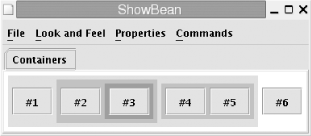11.2 Containers
The second step in creating a GUI is
to place the components you have created and configured into
appropriate containers. Chapter 2 of
Java Foundation Classes in a Nutshell contains
tables that list the container classes available in the AWT and Swing
packages. Many of these container classes have specialized uses.
JFrame is a top-level window, for example, and
JTabbedPane displays the components it contains in
individual tabbed panes (like those pictured in Figure 11-1) but Swing and the AWT also define generic
container classes, such as JPanel.
Example 11-1 is a listing of
Containers.java. This class is a subclass of
JPanel. Its constructor method creates a number of
other nested JPanel instances, as well as a number
of JButton objects contained by those
JPanel classes. Example 11-1
illustrates the concept of the containment hierarchy of a GUI, using
color to represent the nesting depth of the hierarchy. Figure 11-2 shows what the Containers
class looks like when displayed with the ShowBean
program as follows:
% java je3.gui.ShowBean je3.gui.Containers

Example 11-1. Containers.java
package je3.gui;
import javax.swing.*;
import java.awt.*;
/**
* A component subclass that demonstrates nested containers and components.
* It creates the hierarchy shown below, and uses different colors to
* distinguish the different nesting levels of the containers
*
* Containers---panel1----button1
* | |---panel2----button2
* | | |----panel3----button3
* | |------panel4----button4
* | |----button5
* |---button6
*/
public class Containers extends JPanel {
public Containers( ) {
this.setBackground(Color.white); // This component is white
this.setFont(new Font("Dialog", Font.BOLD, 24));
JPanel p1 = new JPanel( );
p1.setBackground(new Color(200, 200, 200)); // Panel1 is darker
this.add(p1); // p1 is contained by this component
p1.add(new JButton("#1")); // Button 1 is contained in p1
JPanel p2 = new JPanel( );
p2.setBackground(new Color(150, 150, 150)); // p2 is darker than p2
p1.add(p2); // p2 is contained in p1
p2.add(new JButton("#2")); // Button 2 is contained in p2
JPanel p3 = new JPanel( );
p3.setBackground(new Color(100, 100, 100)); // p3 is darker than p2
p2.add(p3); // p3 is contained in p2
p3.add(new JButton("#3")); // Button 3 is contained in p3
JPanel p4 = new JPanel( );
p4.setBackground(new Color(150, 150, 150)); // p4 is darker than p1
p1.add(p4); // p4 is contained in p1
p4.add(new JButton("#4")); // Button4 is contained in p4
p4.add(new JButton("#5")); // Button5 is also contained in p4
this.add(new JButton("#6")); // Button6 is contained in this component
}
}
|
